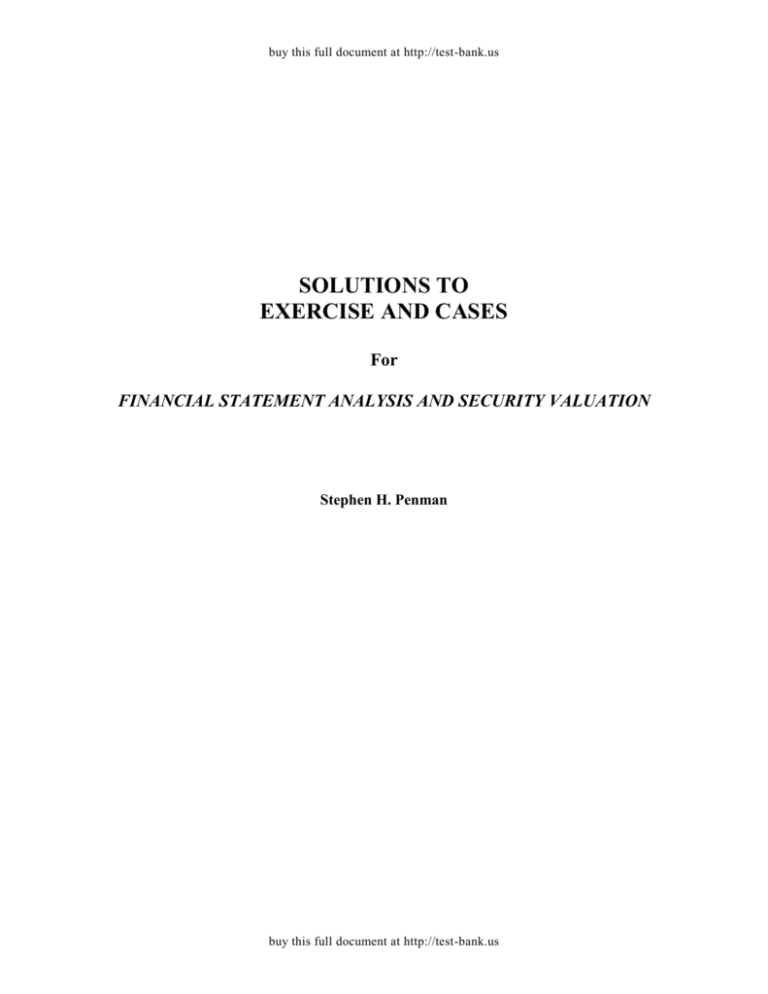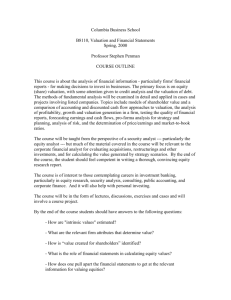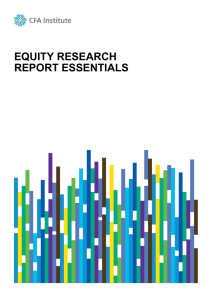FREE Sample Here - Test
advertisement

buy this full document at http://test-bank.us SOLUTIONS TO EXERCISE AND CASES For FINANCIAL STATEMENT ANALYSIS AND SECURITY VALUATION Stephen H. Penman buy this full document at http://test-bank.us Chapter 01 - Introduction to Investing and Valuation CHAPTER ONE Introduction to Investing and Valuation Concept Questions C1.1. Fundamental risk arises from the inherent risk in the business – from sales revenue falling or expenses rising unexpectedly, for example. Price risk is the risk of prices deviating from fundamental value. Prices are subject to fundamental risk, but can move away from fundamental value, irrespective of outcomes in the fundamentals. When an investor buys a stock, he takes on fundamental risk – the stock price could drop because the firm’s operations don’t meet expectations – but he also runs the (price) risk of buying a stock that is overpriced or selling a stock that is underpriced. Chapter 18 elaborates and Figure 18.5 (in Chapter 18) gives a display. C1.2. A beta technology measures the risk of an investment and the required return that the risk requires. The capital asset pricing model (CAPM) is a beta technology; is measures risk (beta) and the required return for the beta. An alpha technology involves techniques that identify mispriced stocks than can earn a return in excess of the required return (an alpha return). See Box 1.1. The appendix to Chapter 3 elaborates on beta technologies. 1-2 buy this full document at http://test-bank.us C1.3. This statement is based on a statistical average from the historical data: The return on stocks in the U.S. and many other countries during the twentieth century was higher than that for bonds, even though there were periods when bonds performed better than stocks. So, the argument goes, if one holds stocks long enough, one earns the higher return. However, it is dangerous making predictions from historical averages when risky investment is involved. Those averages from the past are not guaranteed in the future. Stocks are more risky than bonds – they can yield much lower returns than past averages. The investor who holds stocks (for retirement, for example) may well find that her stocks have fallen when she comes to liquidate them. Waiting for the “long-run” may take a lot of time (and “in the long run we are all dead”). The historical average return for equities is based on buying stocks at different times, and averages out “buying high” and “buying low” (and selling high and selling low). An investor who buys when prices are high (or is forced to sell when prices are low) may not receive the typical average return. Consider investors who purchased shares during the stock market bubble in the 1990s and a lost considerable amount of their retirement “nest egg.” C1.4. A passive investor does not investigate the price at which he buys an investment. He assumes that the investment is fairly (efficiently) priced and that he will earn the normal return for the risk he takes on. The active investor investigates whether the investment is efficiently priced. He looks for mispriced investments that can earn a return in excess of the normal return. See Box 1.1. buy this full document at http://test-bank.us Chapter 01 - Introduction to Investing and Valuation C1.5. This is not an easy question at this stage. It will be answered in full as the book proceeds. But one way to think about it is as follows: If an investor expects to earn 10% on her investment in a stock, then earnings/price should be 10% and price/earnings should be 10. Any return above this would be considered “high” and any return below it “low.” So a P/E of 33 (an E/P yield of 3.03%) would be considered high and a P/E of 8 (an E/P yield of 12.5%) would be considered low. But we would have to also consider how accounting rules measure earnings: If accounting measures result in lower earnings (through high depreciation charges or the expensing of research and development expenditure, for example) then a normal P/E ratio might be higher than 10. C1.6. The firm has to repurchase the stock at the market price, so the shareholder will get the same price from the firm as from another investor. But one should be wary of trading with insiders (the management) who might have more information about the firm’s prospects than outsiders (and might make stock repurchases when they consider the stock to be underpriced). Some argue that stock repurchases are indicative of good prospects for the firm that are not reflected in the market price, and firms make them to signal these prospects. So they buy stocks rather than selling them (back to the firm). C1.7. Yes. Stocks would be efficiently priced at the agreed fundamental value and the market price would impound all the information that investors are using. Stock prices would change as new information arrived that revised the fundamental value. But that new information would be unpredictable beforehand. So changes in prices would also be unpredictable: stock prices would follow a “random walk.” 1-4 buy this full document at http://test-bank.us C1.8. Index investors buy a market index--the S&P 500, say--at its current price. With no one doing fundamental analysis, no one would have any idea of the real worth of stocks. Prices would wander aimlessly, like a “random walk.” A lone fundamental investor might have difficulty making money. He might discover that stocks are mispriced, but could not be sure that the price will ultimately return to “fundamental value.” C1.9. a. If the market price, P, is efficient (in pricing intrinsic value) and V is a good measure of intrinsic value, the P/V ratio should be 1.0. The graph does show than the P/V ratio oscillates around 1.0 (at least up to the bubble years). However, there are deviations from 1.0. These deviations must either be mispricing (in P) that ultimately gets corrected so the ratio returns to 1.0, or a poor measure of V. b. Yes, you would have done well up to 1995 if P/V is an indication of mispricing. When the P/V ratio drops below 1.0, prices increase (as the market returns to fundamental value), and when the P/V ratio rises above 1.0, prices decrease (as the market returns to fundamental value). A long position in the first case and a short position in the latter case would earned positive returns. Of course, this strategy is only as good as the V measure used to estimate intrinsic value. buy this full document at http://test-bank.us Chapter 01 - Introduction to Investing and Valuation c. Clearly, shorting Dow stocks during this period would have been very painful, even though the P/V ratio rose to well above 1.0. Up to 1999, the P/V ratio failed to revert back to 1.0 even though it deviated significantly from 1.0. This illustrates price risk in investing (see question C1.1 and Box 1.1). Clearly, buying stocks when the P/V ratio was at 1.2 would clearly involved a lot of price risk: The P/V ratio says stocks are too expensive and you’d be paying too much. But selling short at a P/V ratio of 1.2 in 1997 would also have borne considerable price risk, for the P/V ratio increase even further subsequently. In bubbles or periods of momentum investing, overpriced stocks get more overpriced, so taking a position in the hope that prices will return to fundamental value is risky. Only after the year 2000 did prices finally turn down, and the P/V ratio fell back towards 1.0. Chapter 5 elaborates on the calculation of P/V ratios. 1-6 buy this full document at http://test-bank.us Exercises Drill Exercises E1.1. Calculating Enterprise Value This exercise tests the understanding of the basic value relation: Enterprise Value = Value of Debt + Value of Equity Enterprise Value = $600 + $1,200 million = $1,800 million (Enterprise value is also referred to as the value of the firm.) E1.2. Calculating Value Per Share Rearranging the value relations, Equity Value = Enterprise Value – Value of Debt Equity Value = $2,700 - $900 million = $1,800 Value per share on 900 million shares = $1,800/900 = $2.00 E1.3 Buy or Sell? Value = $850 + $675 = $1,525 million Value per share = $1,525/25 = $61 Market price = $45 Therefore, BUY! buy this full document at http://test-bank.us Chapter 01 - Introduction to Investing and Valuation Applications E1.4. Finding Information on the Internet: Dell Computer and General Motors This is an exercise in discovery. The links on the book’s web site will help with the search. Here is the link to yahoo finance: http://finance.yahoo.com E1.5. Enterprise Market Value: General Mills and Hewlett-Packard (a) General Mills Market value of the equity = $62 337.5 million shares = Book value of total (short-term and long-term) debt = Enterprise value $20,925.0 million 4,790.7 $16,134.3 million Note three points: (i) Total market value of equity = Price per share Shares outstanding. (ii) The book value of debt is typically assumed to equal its market value, but financial statement footnotes give market value of debt to confirm this. (iii) The book value of equity is not a good indicator of its market value. The price-tobook ratio for the equity can be calculated from the numbers given: $20,925/$6,215.8 = 3.37. 1-8 buy this full document at http://test-bank.us (b) This question provokes the issue of whether debt held as assets is part of enterprise value (a part of operations) or effectively a reduction of the net debt claim on the firm. The issue arises in the financial statement analysis in Part II of the book: are debt assets part of operations or part of financing activities? Debt is part of financing activities if it is held to absorb excess cash rather than used as a business asset. The excess cash could be applied to buying back the firm’s debt rather than buying the debt of others, so the net debt claim on enterprise value is what is important. Put another way, HP is not in the business of trading debt, so the debt asset is not part of enterprise operations. The calculation of enterprise value is as follows: Market value of equity = $47 2,473 million shares = $116,231 million Book value of net debt claims: Short-term borrowing $ 711 million Long-term debt 7,688 Total debt Debt assets $8,399 million 11,513 Enterprise value (3,114) 113,117 million E1.6. Identifying Operating, Investing, and Financing Transactions (a) Financing (b) Operations (c) Operations; but advertising might be seen as investment in a brand-name asset (d) Financing (e) Financing (f) Operations buy this full document at http://test-bank.us Chapter 01 - Introduction to Investing and Valuation (g) Investing. R& D is an expense in the income statement, so the student might be inclined to classify it as an operating activity; but it is an investment. (h) Operations. But an observant student might point out that interest – that is a part of financing activities – affects taxes. Chapter 9 shows how taxes are allocated between operating and financing activities in this case. (i) Investing (j) Operations 1-10 buy this full document at http://test-bank.us Minicases M1.1 Critique of an Equity Analysis: America Online, Inc. Introduction This case can be used to outline how the analyst goes about a valuation and, specifically, to introduce pro forma analysis. It can also be used to stress the importance of strategy in valuation. The case involves suspect analysis, so is the first in an exercise (repeated throughout the book) that asks: What does a credible equity research report look like? The case can also be introduced with the Apple example is Box 1.6. The case anticipates some of the material in Chapter 3. You may wish to introduce that material with this case – by putting Figures 3.2 and 3.3 in front of the students, for example. buy this full document at http://test-bank.us Chapter 01 - Introduction to Investing and Valuation You may wish to recover the original Wall Street Journal (April 26, 1999) piece on which this case is based and hand it out to students. It is available from Dow Jones News Retrieval. With the piece in front of them, students can see that it has three elements that are important to valuation – scenarios about the future (including the future for the internet, as seen at the time), a pro forma analysis that translates the scenario into numbers, and a valuation that follows from the pro forma analysis. So the idea – emphasized in Chapter 3 -- that pro forma analysis is at the heart of the analysis is introduced, but also the idea that pro forma analysis must be done with an appreciation for strategy and scenarios that can develop under the strategy. To value a stock, an analyst forecasts (based on a scenario), and then converts the forecast to a valuation. An analysis can thus be criticized on the basis of the forecasts that are made or on the way that value is inferred from the forecast. Students will question Alger's forecasts, but the point of the case is to question the way he inferred the value of AOL from his forecasts. 1-12 buy this full document at http://test-bank.us Working the Case A. Calculation of price of AOL with a P/E of 24 in 2004 Earnings in 2004 for a profit margin of 26% of sales: $16.000 0.26 $4.160 billion Market value in 2004 with a P/E ratio of 24 $99.840 Present value in 1999 (at a discount rate of 10%, say) $61.993 Shares outstanding in 1999 Value per share, 1999 1.100 $56.36 (Students might quibble about the discount rate; the sensitivity of the value to different discount rates can be looked at.) B. Market value of equity in 1999: 105 1.10 billion shares $115.50 billion Future value in 2004 (at 10%) $186.014 Forecasted earnings, 2004 $4.160 billion Forecasted P/E ratio 44.7 So, if AOL is expected to have a P/E of 50 in 2004, it is a BUY. buy this full document at http://test-bank.us Chapter 01 - Introduction to Investing and Valuation C. Use Box 1.6 as background for this part. There are two problems with the analysis: 1. The valuation is circular: the current price is based on an assumption about what the future price will be. That future price is justified by an almost arbitrary forecast of a P/E ratio. The valuation cannot be made without a calculation of what the P/E ratio should be. Fundamental analysis is needed to break the circularity. Alger justified a P/E ratio of 50, based on - Continuing earnings growth of 30% per year after 2000 - “Consistency” of earnings growth - An "excitement factor" for the stock. Is his a good theory of the P/E ratio? Discussion might ask how the P/E ratio is related to earnings growth (Chapter 6) and whether 30% perpetual earnings growth is really possible. What is "consistency" of earnings growth? What is an "excitement factor"? How does one determine an intrinsic P/E ratio? 2. The valuation is done under one business strategy--that of AOL as a stand-alone, internet portal firm. The analysis did not anticipate the Time Warner merger or any other alternative paths for the business. (See box 1.4 in the text). To value an internet stock in 1999, one needed a well-articulated story of how the "Internet revolution" would resolve itself, and what sort of company AOL would look like in the end. 1-14 buy this full document at http://test-bank.us Further Discussion Points Circular valuations are not uncommon in the press and in equity research reports: the analyst specifies a future P/E ratio without much justification, and this drives the valuation. Tenet 11 in Box 1.6 is violated. The ability of AOL to make acquisitions like its recent takeover of Netscape will contribute to growth -- and Alger argued this. But, if AOL pays a “fair price” for these acquisitions, it will just earn a normal return. What if it pays too much for an overvalued internet firm? What if it can buy assets (like those of Time Warner) cheaply because its stock is overpriced? This might justify buying AOL at a seemingly high price. Introduce the discussion on creating value by issuing shares in Chapter 3. The value of AOL’s brand and its ability to attract and retain subscribers are crucial. The competitive landscape must be evaluated. Some argue that entry into internet commerce is easy and that competition will drive prices down. Consumers will benefit tremendously from the internet revolution, but producers will earn just a normal return. A 26% profit margin has to be questioned. The 1999 net profit margin was 16%. A thorough analysis would identify the main drivers of profitability and the growth. - analysis of the firm’s strategy - analysis of brand name attraction - analysis of churn rates in subscriptions - analysis of potential competition - analysis of prospective mergers and takeovers and “synergies” that might be available - analysis of margins. buy this full document at http://test-bank.us Chapter 01 - Introduction to Investing and Valuation Postscript David Alger, president of Fred Alger Management Inc., perished in the September 11, 2001 devastation of the World Trade Center in New York, along with many of his staff. The Alger Spectra fund was one of the top performing diversified stock fund of the 1990s. 1-16









